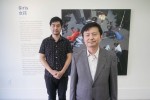Taiwanese-American Stephen Ou found a space that felt like home during his casual walk down Westwood Boulevard.
Ou paused last November when he saw a sign for the Taiwan Academy Los Angeles, a small art gallery across the street from the Hammer Museum, he said.
He knew then he had to apply for a job at the Academy, said Ou, a UCLA Design | Media Arts alumnus.
Ou, who grew up in Taiwan and moved to America when he was in high school, now works as a gallery assistant and graphic designer for the Taiwan Academy. The Academy is one of several international institutions the Ministry of Culture of the Republic of China established to promote Taiwan’s culture around the world. Through the Taiwan Academy, Ou has collaborated with the Department of Art History at UCLA and other local art institutions, bringing visibility to contemporary Taiwanese art, he said.
Most recently, he helped feature the work of Isa Ho,a contemporary female artist whose surrealist photograph series “Girls Falling” will be on display until Wednesday. As a graphic designer for the Academy, Ou installed the vinyl wall captions around the gallery to explain the exhibit. He said Ho’s images feature layered photographs of falling women, animals and objects against Taiwanese landscapes, illustrating both Taiwanese culture and progressive feminist themes.
Ou said working for the Taiwan Academy connects to his background in Design | Media Arts as well as his personal history growing up in Taiwan.
“From what I’ve seen, the youth in Taiwan have always been pretty active and there has really been an immense creative energy within the artist community,” Ou said. “It was a nice coincidence … that there happened to be an organization here representing Taiwanese culture and the arts.”
The Academy’s location next to UCLA helped attract some foot traffic to the gallery, and most of the students who come in are first or second generation Taiwanese Americans, Ou said.
“There is a space for them to share a piece of home here near school,” Ou said.
Ou has stayed in touch with UCLA through the Taiwan Academy. In May, he said he recommended Ho as a guest speaker for Chinese art associate professor Hui-shu Lee’s class, Art in Modern China. During the lecture, Ou served as a translator between the artist and students.
Lee, whose work centers on contemporary Asian artists, said the Taiwan Academy is a valuable resource to complement her teaching at UCLA.
“When you have an artist come to the class, students just love it,” Lee said. “They have the opportunity face-to-face to respond or challenge or pose questions to the artists.”
The Taiwan Academy distinguishes itself from other local art institutions like the Los Angeles County Museum of Art because it hones in specifically on contemporary Taiwanese culture and highlights the work of living artists, rather than ancient Asian relics or artifacts, Lee said.
“The Taiwan Academy has a clear vision, and there are a lot of things they can do with that,” Lee said. “It’s not just promoting Taiwanese culture – it’s a window and an outlet, and it’s so close to us.”
Ou said his work at the Academy has helped show audiences a clear picture of Taiwanese art as its own entity, since many new viewers do not distinguish between mainland Chinese and Taiwanese culture.”
“It’s overshadowed a lot of of times by more traditional Chinese art,” Ou said.
Bill Su-pao Chang, director of the Taiwan Academy, said connecting with UCLA through former students like Ou and partnerships with the Department of Art History have helped the Academy achieve its mission of bringing understanding of Taiwanese culture to the West Coast.
“It’s a cultural exchange, bring the Taiwanese culture to America,” Chang said. “That’s the goal, so it’s all about choosing the best practice so we can achieve that.”
After Ho’s exhibit closes, the next art show at the Taiwan Academy will be a series of modern sculptures and installation pieces by 27-year-old artist Hao Ni in August. Ni’s work will resonate with viewers regardless of their cultural backgrounds, Ou said, because it features universally familiar imagery of cigarettes and ash to illustrate the contrast between modern technology and nature.
As an artist himself, Ou said his favorite part of working with the Taiwan Academy is learning about new artists like Ho and Ni from his home country.
“Working at the Taiwan Academy has brought me to know a lot of contemporary artists that are from my home,” Ou said.
